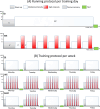Effect of different running protocols on bone morphology and microarchitecture of the forelimbs in a male Wistar rat model
- PMID: 39509380
- PMCID: PMC11542884
- DOI: 10.1371/journal.pone.0308974
Effect of different running protocols on bone morphology and microarchitecture of the forelimbs in a male Wistar rat model
Abstract
Background: It is accepted that the metabolic response of bone tissue depends on the intensity of the mechanical loads, but also on the type and frequency of stress applied to it. Physical exercise such as running involves stresses which, under certain conditions, have been shown to have the best osteogenic effects. However, at high intensity, it can be deleterious for bone tissue. Consequently, there is no clear consensus as to which running modality would have the best osteogenic effects.
Aim: Our objective was to compare the effects of three running modalities on morphological and micro-architectural parameters on forelimb bones.
Methods: Forty male Wistar rats were randomly divided into four groups: high intensity interval training (HIIT), continuous running, combined running ((alternating HIIT and continuous modalities) and sedentary (control). The morphometry, trabecular microarchitecture and cortical porosity of the ulna, radius and humerus were analyzed using micro-tomography.
Results: All three running modalities resulted in bone adaptation, with an increase in the diaphyseal diameter of all three bones. The combined running protocol had positive effects on the trabecular thickness in the distal ulna. The HIIT protocol resulted in an increase in both medio-lateral diameter and cortical bone area over total area (Ct.Ar/Tt.Ar) at the ulnar shaft compared with sedentary condition. Moreover, the HIIT protocol decreased the mean surface area of the medulla (Ma.Ar) according to sedentary condition at the ulnar shaft.
Conclusion: This study has shown that HIIT resulted in a decrease in trabecular bone fraction in favor of cortical bone area at the ulna.
Copyright: © 2024 Xavier et al. This is an open access article distributed under the terms of the Creative Commons Attribution License, which permits unrestricted use, distribution, and reproduction in any medium, provided the original author and source are credited.
Conflict of interest statement
The authors have declared that no competing interests exist.
Figures





References
-
- Wolff J. The Law of Bone Remodelling. The Law of Bone Remodelling. Published Online First: 1986. doi: 10.1007/978-3-642-71031-5 - DOI
MeSH terms
LinkOut - more resources
Full Text Sources
Research Materials

